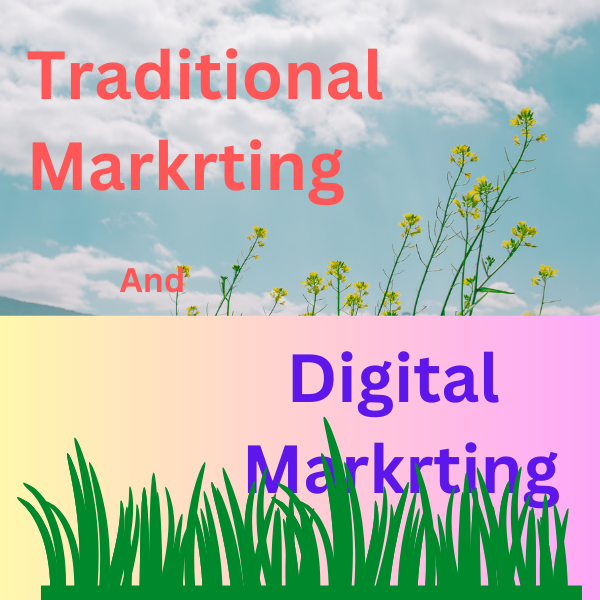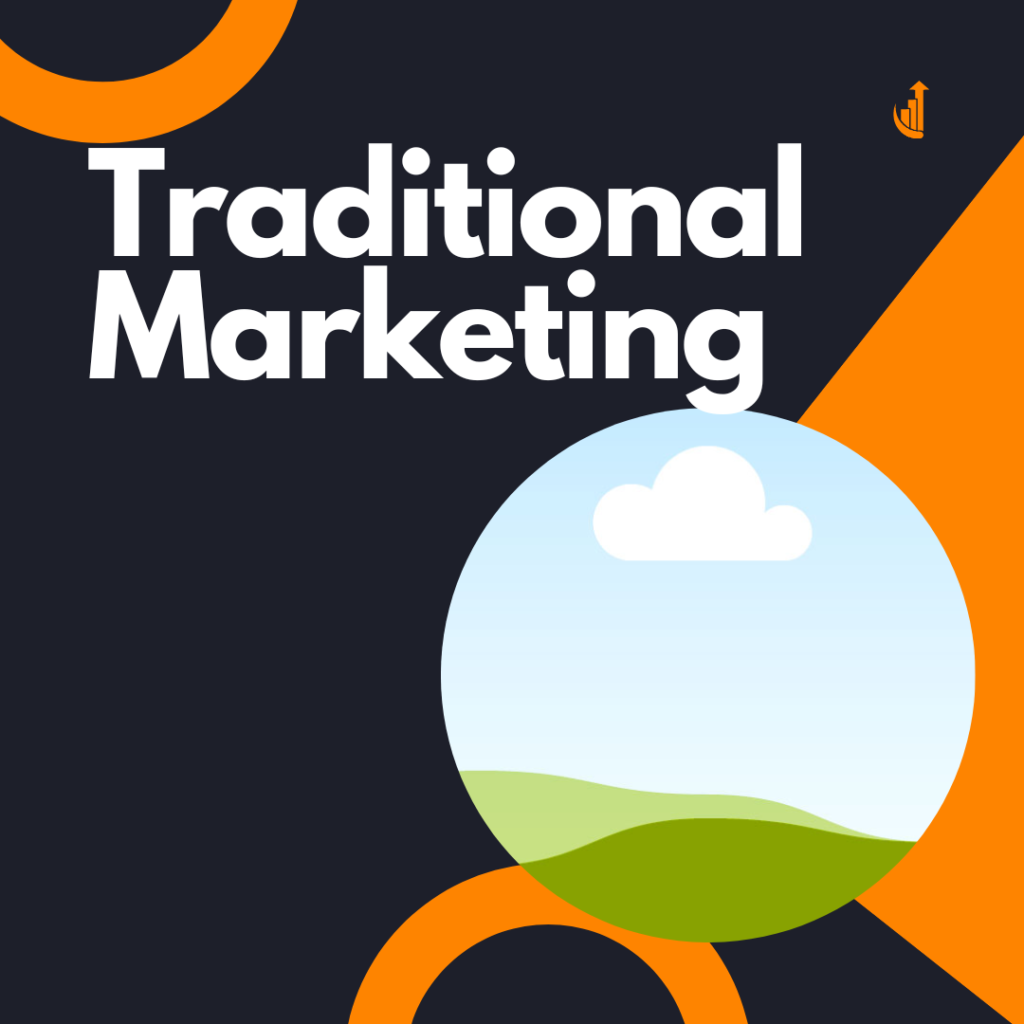
Traditional Marketing and Digital Marketing are two different approaches to marketing that aim at achieving similar goals; i.e., promoting goods and services, and reaching the target audience. Traditional Marketing is a marketing approach that uses conventional methods to promote goods and services; however, Digital Marketing uses online platforms and digital technologies to promote goods and services.
What is Traditional Marketing?

These marketing materials are usually inserted in locations where their Traditional Marketing is a form of marketing that uses conventional methods/offline media to reach the target audience. It uses offline channels like television, direct mail, radio, telemarketing, and billboards. It is a one-way communication marketing approach and allows businesses to broadcast their message to a large audience with no or less interaction. target audience is more likely to see, hear, or engage with them.
Features of Traditional Marketing:
- One-way Communiation: Organisations deliver their messages in a one-way manner, and do not usually provide the audience with the opportunity to interact or provide feedback.
- Offline Channels: It uses offline channels like TV, magazines, radio, billboards, etc.
- Tangible Materials: It also uses some tangible materials to deliver its message or promote a product or service. These materials include flyers, brochures, posters, etc.
- High Cost: The traditional marketing campaigns require quite high financial investment as the cost associated with broadcasting, printing, and distributing tangible materials is high.
What is Digital Marketing?

Digital Marketing is a form of marketing that uses online platforms and digital technologies to reach the target audience. For this, the organisations leverages social media, internet, search engines, mobile apps, email, and other digital channels. It is a two-way communication marketing approach and allows the organisation and audience to interact with each other, engage properly, and provide feedback and/or suggestions. Digital Marketing offers the organisation with numerous tools and techniques to target specific audience, measure their campaign performance, and optimise strategies.
Features of Digital Marketing:
- Two-way Communication: With digital marketing, organisations can interact with their audience, allow them to provide feedback and comments, and engage with the properly.
- Online Channels: It uses online channels like websites, email, social media platforms, mobile apps, search engines, etc.
- Multimedia Content: It uses multimedia content like images, videos, infographics, etc., for user engagement across different online platforms.
- Cost: As compared to traditional marketing, digital marketing can be more cost-effective. It is because digital marketing usually include low overhead cost and has more advertising options.
Difference between Traditional Marketing and Digital Marketing
| Basis | Traditional Marketing | Digital Marketing |
| Meaning | Traditional Marketing is a form of marketing that uses conventional methods/offline media to reach the target audience. | Digital Marketing is a form of marketing that uses online platforms and digital technologies to reach the target audience. |
| Reach & Targeting | It frequently uses a wide range of media, including print, radio, and television, to reach a large audience. | Precise targeting according to geography, interests, habits, and demographics is made possible by digital marketing. |
| Cost | It may be costly, particularly for print advertising or television commercials. Expenses are frequently set and might not offer comprehensive ROI information. | Digital Marketing provides different low-cost solutions, ranging from pay-per-click advertising to free advertising (organic social media). Digital campaigns often have lower costs. |
| Interactivity & Engagement | Traditional Marketing involves a one-way communication strategy with little room for involvement or interaction. | Digital Marketing enables interaction through likes, shares, comments, reviews, and other forms of two-way communication. |
| Flexibility & Agility | In traditional marketing, once a campaign begins, it usually becomes harder to modify and frequently requires a large lead time. | Real-time adjustments based on performance indicators, trends, and feedback are possible with digital marketing. Campaigns may be easily adjusted or changed as needed. |
| Measurability & Analytics | Brand awareness, recall, and reach are among the metrics utilized in traditional marketing but exact measurement is not always easy to achieve. | Digital Marketing offers a variety of analytics tools for monitoring user activity, campaign performance, conversion rates, and return on investment. Data-driven insights make optimization and continuous enhancement possible. |
| Tangibility & Brand Presence | In Traditional Marketing print advertisements, billboards, and brochures are examples of tangible items that can make an impression. | Digital marketing is the practice of promoting brands virtually using online platforms including social media, email, and webpages. |
| Global v/s Local Impact | Traditional Marketing is appropriate for companies that target particular geographic areas since it can have a big local impact. | Global reach is made possible by digital marketing, which is perfect for companies looking to grow abroad |
Traditional Marketing and Digital Marketing – FAQs
Traditional Marketing helps an organisation in reaching large audience, offers flexibility by allowing the organisation to use a variety of channels and techniques in customising its strategies, and offers tagible materials like brochures, flyers, etc., for physical interaction with the customers.
Advantages of Digital Marketing:
- Cost-Effective: Digital marketing offers a cost-effective way for businesses of all sizes to reach a larger audience and increase brand awareness.
- Advanced Targeting Options: Digital marketing offers advanced targeting options that allow businesses to reach specific demographics and target customers based on their interests, behaviors, and location.
- Measurable Results: Digital marketing provides real-time data and analytics that allow businesses to track the effectiveness of their campaigns and make data-driven decisions.
- Flexibility: Digital marketing offers a variety of channels, including search engine optimization, pay-per-click advertising, email marketing, and more, allowing businesses to tailor their approach to their specific needs and goals.
Disadvantages of Digital Marketing:
- Limited Personalization: Digital marketing can sometimes lack the personalization and human touch that traditional marketing methods offer.
- Increased Competition: Digital marketing is highly competitive, and businesses must continually adapt and innovate to stay ahead of the competition.
- Overwhelming: The vast array of digital marketing channels and tactics can be overwhelming, and businesses may struggle to determine the most effective approach for their specific needs.
- Ad-Blockers: Ad-blockers can limit the effectiveness of digital marketing efforts, as customers may not see the ads.
Similarities, including:
- Both involve online marketing: Social Media Marketing and Digital Marketing both take place online, using digital channels to reach a target audience.
- Both aim to increase brand awareness: The primary goal of both Social Media Marketing and Digital Marketing is to increase brand awareness and reach a larger audience.
- Both involve targeting specific audiences: Both approaches involve targeting specific demographics and customer segments to reach a specific audience.
- Both require data analysis: Social Media Marketing and Digital Marketing both require data analysis to measure the effectiveness of campaigns and make data-driven decisions.
- Both require content creation: Both approaches require content creation to engage with customers and provide value to the target audience.
- Both can be cost-effective: Both Social Media Marketing and Digital Marketing can be cost-effective compared to traditional marketing channels, making them accessible to businesses of all sizes.
- Both can be cost-effective: Both Social Media Marketing and Digital Marketing can be cost-effective compared to traditional marketing channels, making them accessible to businesses of all sizes.
